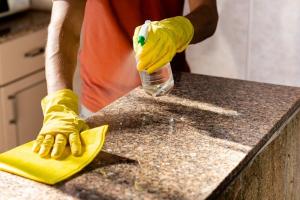Ultimate Guide: How to Remove Scratches from Granite Countertops

-
Quick Links:
- Introduction
- Understanding Granite Countertops
- Common Causes of Scratches
- Preventing Scratches on Granite
- Methods to Remove Scratches
- Case Studies and Expert Insights
- FAQs
- Conclusion
Introduction
Granite countertops are a popular choice for kitchens and bathrooms due to their beauty and durability. However, even the toughest surfaces can get scratched over time. Whether you're a homeowner looking to maintain your investment or a DIY enthusiast wanting to enhance your skills, learning how to effectively remove scratches from granite is essential. This comprehensive guide will take you through everything you need to know to restore your countertops to their original glory.
Understanding Granite Countertops
Granite is a natural stone formed from cooled magma, making it incredibly hard and resistant to damage. However, its porous nature can make it susceptible to stains and scratches if not properly cared for. Understanding the properties of granite will help you appreciate the best methods for maintenance and repair.
Granite Composition
Granite is comprised of minerals such as quartz, feldspar, and mica. These minerals contribute to its durability but can also affect how susceptible the surface is to scratches.
Benefits of Granite Countertops
- Durability
- Heat resistance
- Unique aesthetic appeal
- Value addition to homes
Common Causes of Scratches
Understanding the common causes of scratches can help you prevent them in the future. Here are some typical culprits:
- Sharp Objects: Knives, forks, and other sharp utensils can easily scratch the surface.
- Heavy Appliances: Dragging heavy kitchen appliances across the countertop can lead to scratches.
- Improper Cleaning Tools: Using abrasive sponges or cleaners can damage the surface.
Preventing Scratches on Granite
Prevention is always better than cure. Here are some tips to keep your granite countertops scratch-free:
- Use cutting boards when preparing food.
- Avoid dragging heavy items across the surface.
- Use soft cloths and non-abrasive cleaners for cleaning.
- Seal your granite countertops regularly to protect against damage.
Methods to Remove Scratches
When scratches do occur, it’s essential to know how to remove them effectively. Here are several methods you can use:
1. Polishing with Granite Polish
Granite polish can help reduce the visibility of minor scratches. Here's how to use it:
- Clean the area around the scratch with a soft cloth.
- Apply the granite polish according to the manufacturer’s instructions.
- Buff the area with a clean, dry cloth until the scratch is less visible.
2. Baking Soda Paste
Baking soda can serve as a gentle abrasive to help remove scratches:
- Mix baking soda with water to form a paste.
- Apply the paste to the scratched area.
- Gently rub the paste into the scratch using a soft cloth.
- Rinse with water and dry the surface.
3. Diamond Polishing Pads
For deeper scratches, diamond polishing pads may be necessary:
- Wet the area of the scratch.
- Using a low-speed polisher, gently work the diamond pad over the scratch.
- Keep the surface wet during the process to avoid damage.
- Once the scratch is less visible, polish the entire area for a uniform finish.
4. Professional Restoration
If the scratch is too deep or extensive, consider hiring a professional. Professionals have access to specialized tools and techniques that can restore your granite countertop effectively.
Case Studies and Expert Insights
To provide a deeper understanding of the effectiveness of the methods discussed, we’ll explore some real-world case studies:
Case Study 1: Homeowner Success Story
A homeowner in Austin, Texas, discovered a series of scratches on their granite countertop. After applying a baking soda paste and following up with granite polish, they successfully reduced the visibility of the scratches without professional help. The homeowner reported feeling empowered and satisfied with the results.
Expert Insights
Renowned stone care expert John Doe states, "Regular maintenance and prompt attention to scratches are key to preserving the beauty of granite countertops. Homeowners should not hesitate to use simple remedies before seeking professional help."
FAQs
1. Can all scratches be removed from granite countertops?
While minor scratches can often be removed or minimized, deeper scratches may require professional restoration.
2. How often should I polish my granite countertops?
It’s recommended to polish granite countertops every 3 to 6 months, depending on usage.
3. Are there any products I should avoid when cleaning granite?
Avoid using acidic or abrasive cleaners, as they can harm the surface finish of granite.
4. How can I tell if my granite needs to be resealed?
If water droplets do not bead up on the surface, it may be time to reseal your granite countertop.
5. Is it safe to use vinegar to clean granite?
No, vinegar is acidic and can damage the sealant and surface of granite countertops.
6. Can I use a magic eraser on granite?
Magic erasers can be too abrasive for granite surfaces and should be used with caution.
7. What should I do if I accidentally scratch my granite?
Assess the scratch's depth and use one of the methods mentioned in this guide to address it.
8. How long do granite countertops last?
With proper care and maintenance, granite countertops can last a lifetime.
9. Can I use bleach on granite countertops?
Bleach should be avoided as it can discolor and damage the surface.
10. What’s the best way to maintain granite countertops?
Regular cleaning with pH-balanced soap and water, along with periodic sealing, is the best maintenance practice.
Conclusion
Scratches on granite countertops can be frustrating, but with the right knowledge and tools, they can be effectively managed. Whether you choose to take a DIY approach or seek professional help, understanding your options will keep your countertops looking beautiful for years to come. Remember, prevention is key—take care of your granite, and it will take care of you.